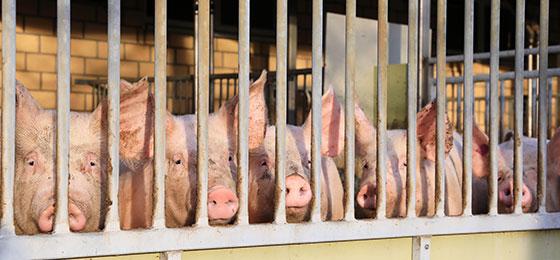Completed project: Antibiotic resistance at Swiss pig farms

Researchers found relatively few antibiotic-resistant bacteria in fattening pigs. However, it is unclear whether there is a resulting health risk for farmers.
Various antibiotic-resistant bacteria can be transferred from livestock to humans. The primary bacteria of concern in pigs are enterobacteria ( E. coli ) that are resistant to colistin or the cephalosporin group of antibiotics. However, little is known about how serious the risks of transmission to humans – especially pig farmers – actually are, and which factors influence these risks. This is something that Markus Hilty and his team from the Institute for Infectious Diseases at the University of Bern have now investigated in partnership with other research institutions.
The researchers adopted a One Health approach to their investigations. In addition to looking at how the incidence of resistant pathogens changed in the pigs themselves throughout their life cycle, they also took and analysed samples from the farmers and the area surrounding the farms (from the ground, for example). Using whole genome sequencing (WGS) they were able to determine not only whether the resistant pathogens themselves are transmitted, but also whether they share their resistance genes with other bacteria in the human gut or in the environment. This is important because the ability of bacteria to transfer their genes "horizontally" is a key factor in the spread of resistance across various bacterial species.
Low resistant bacterial load that decreases over time
Between 2017 and 2019, Markus Hilty and his team took several samples from groups of thirty pigs at more than thirty farms. They found the highest incidence of the resistant pathogens they were looking for in unweaned piglets. Just over 6% of these samples contained cephalosporin-resistant enterobacteria, while just over 5% of samples contained colistin-resistant enterobacteria. These figures declined once the pigs started eating regular feed and fell even further during the final (fattening) phase of their lives. Less than 2% and 4% of the samples taken from animals in this phase of life contained cephalosporin-resistant or colistin-resistant enterobacteria respectively.
The researchers feel these low percentages are little cause for concern, believing they are attributable to the overall decline in antibiotic use in the veterinary sector. However, farms varied tremendously in terms of the spread of resistant pathogens. This was not, as might have been expected, primarily due to the quantity of antibiotics used at a farm, but instead to the key factor of animal husbandry practices. Antibiotic-resistant bacteria levels were substantially lower in all-in, all-out (AIAO) systems, in which all pigs are moved to cleaned pens at the same time and do not mix with other pigs until they are slaughtered.
Changes in pig farmers' intestinal microbiota
Since enterobacteria primarily colonise the intestines, Hilty and his team also investigated the composition of the microbial community – what is known as the intestinal microbiota – in pig farmers' intestines. Samples of the farmers' stools tested by gene sequencing were found to contain an elevated proportion of bacteria that are typically found in pigs. This indicates that coming into close contact with pigs for work purposes affects the intestinal microbiota. Provisional data analyses show that the situation is similar for antibiotic-resistant pathogens. However, further studies will have to investigate whether this presents a health risk. Despite this, it would be relatively simple to improve preventive measures. For example, the researchers found that a large number of micro-organisms are transmitted by aerosols. Farmers could avoid inhaling these aerosols by wearing FFP2 face masks, something they rarely do at the moment.
May 2022
